Oracle Designer/2000
Model-driven solutions for
Enterprise Scale Development
Designer/2000 empowers your organization to deliver enterprise solutions for your corporate business imperatives. All staff, business process experts, business analysts, systems designers and application developers derive team synergy from a shared repository complemented by an integrated suite of modelling tools and system generators. Designer/2000 frees you to design and deliver accurate and timely enterprise systems that are adaptable to your changing business application needs.
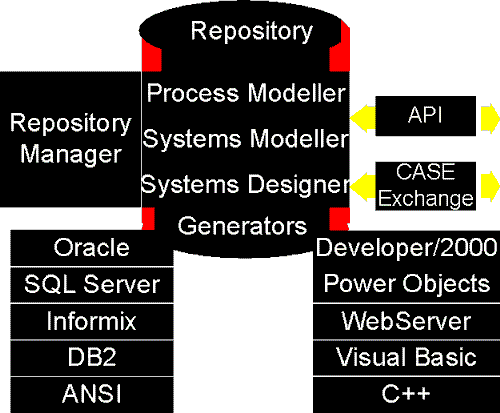
FIGURE 1 DESIGNER2000 ARCHITECTURE
Business Process Reengineering
Utilize the Designer/2000 Process Modeler to analyze and redesign fundamental business processes through management-focused techniques. Build multimedia process flow models, complete with icons, sound, images, and full-motion video, to capture business process definitions and the organisational agents that execute them. Process animation brings your time-scaled process models to life illustrating issues and opportunities that challenge your organization. With BPR techniques, organizations gain a profound understanding of business opportunities and the methods necessary to pursue them.
Visual Systems and Design Modelling
The Designer/2000 systems and design modelling components enable analysts to leverage process-based models or create new ones. The information and function modelling diagrammers are used to construct models that capture business and user needs by recording the logical and physical structures required in business systems.
Model-Driven Systems Development
Designer/2000ís repository-driven requirements models speed the construction and ongoing maintenance of production systems. For Developer/2000, WebServer, PowerObjects and Visual Basic applications, GUI layout, database access, server logic, and application logic are automatically created, incorporating flexible application partitioning for optimal client/server processing. Employ well-defined templates to ensure enterprise-wide, consistent application user interfaces that adopt the native look-and-feel and layout standards defined in the repository, whether the deployment target is the Web, Windows, Macintosh or Motif.
Open Repository
Non-Oracle repositories and tools are easily integrated into the Designer/2000 environment. Use the Designer/2000 open Application Programmer Interface (API) to integrate third-party tools and applications, or customize your own interfaces. Alternatively, employ Oracle CASE Exchange(r) to import or export entity, function, and process model information with other popular repository frameworks and tools. Your investment in systems specification is protected regardless of the frameworks you have chosen.
DESIGNER/2000 OVERVIEW
Process Modelling
Visualize and dramatically improve fundamental business processes with Designer/2000's process modelling capabilities. Gain significant competitive advantage, reduce costs, and improve quality by understanding inter-organization dependencies and process-cycle durations. Identify proposed and existing multilevel organization units, and view them in an easily understood form. Apply icons to identify process steps and their interactions, and enter cost and timing parameters for each process step. Use process animation and multimedia to reveal issues and opportunities to management and users as they watch complete process steps execute from start to finish in a time-scaled environment. Collect further information and perform ad hoc analysis through interfaces to popular desktop spreadsheets. Promote a shared vision of change through the real-time availability of process models in the Designer/2000 repository.
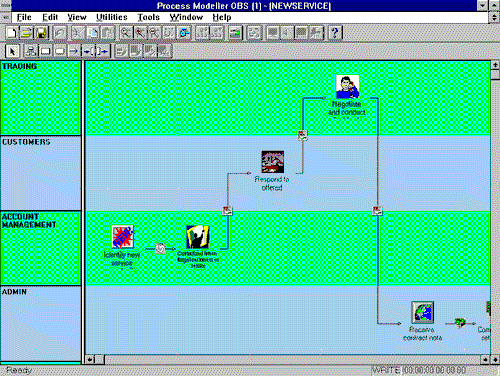
Systems Modelling
Designer/2000 simplifies rapid model-driven development through powerful and intuitive industry-standard modelling methods. Use entity relationship, function hierarchy, dataflow, and matrix modelling techniques, or reuse definitions from process models to capture the structure and inter-relationships of all systems objects. Through the Designer/2000 repository, control the sharing and reuse of application objects across multiple projects. Use the intuitive windowing environment to integrate popular desktop applications into your diagrams, and publish your diagrams through Object Linking and Embedding (OLE2).
Designer/2000 employs a repository object navigator for advanced navigation and display of an entire repository structure. Improve team and personal productivity through drag-and-drop object reuse, easy property and relationship modification, and the creation of fully documented reports on the structure and content of your shared business repository.
The clarity and ease of use of the system's modelling tools combined with the sophisticated navigation facilities ensures a solid foundation for the design and implementation of applications and data warehouse solutions.

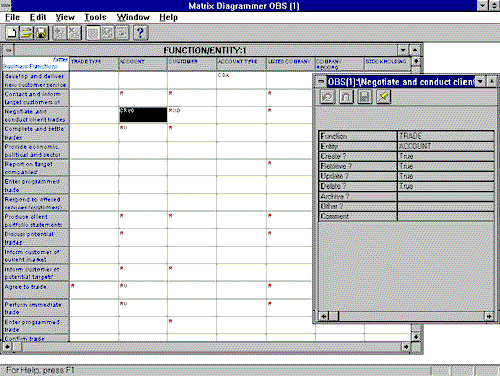
Systems Design
Utilize Designer/2000 to implement distributed client/server and web-based systems. Take direct developer input or use the Design Wizards to rapidly derive systems designs from your requirements definitions. Your data structure and Developer/2000, Power Objects or Visual Basic program designs materialize quickly and accurately.
Use an integrated suite of diagrammers and navigators to create and manipulate table details, foreign keys, and data validation rules. In addition, define server-based triggers along with their triggering conditions, functions, and procedures. Designer/2000 makes client/server code partitioning easier than ever -- register your rules declaratively as client, client/server, or server implementations in preparation for the generation of balanced client/server applications.
Harness powerful module diagrammers to define the structure of your applications, their component program modules, and the interactions among them by simply dragging and dropping re-usable components onto your desktop. Intelligent, graphical syntax-directed construction and modification of procedural definitions of PL/SQL, JavaScript and Basic, provide the full range of required functionality for leading programming environments.
User preferences and templates define the overall visual and semantic characteristics of the generated systems, creating a re-usable styleguide and eliminating inconsistent and inefficient screen painting. Designer/2000 delivers the tools you need to rapidly design and implement client/server and web-based applications, whilst ensuring that they can be changed quickly and accurately in accordance with evolving business needs.
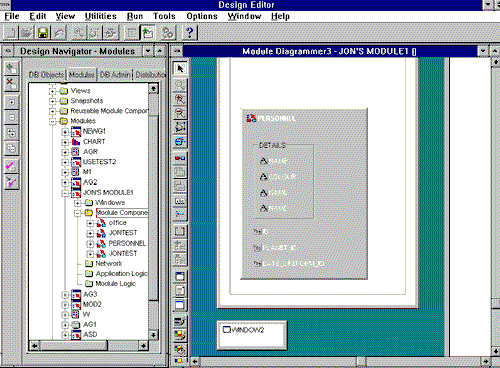
A Universal Design Model
Generate high-quality programs for Developer/2000, the Web, Power Objects and Visual Basic, with support for client-side application logic integrated with the event model for the target platform. Realize your database design options with open server generation and design recovery for all Oracle database types, as well as DB2, Sybase, SQL Server and ODBC databases.
Client Application Generation
Use Designer/2000 to automatically build Developer/2000 applications. Generated applications include multi-screen layouts, sophisticated reports, navigation through menus, buttons and pop-lists, client-side application logic, and full database access functionality-all derived from the designs stored in the Designer/2000 repository. Templates drive the appearance of a rich collection of GUI controls on generated screens, such as images, dialogs, pop-lists, radio groups, check boxes, iconic buttons, and more. Designer/2000 generates applications that not only run on multiple platforms with full native look-and-feel, but also exploit each platform's native features, such as OLE 2 and OCX controls. Employ the same design model to generate Power Objects, Oracle's uniquely powerful development environment for BASIC developers, complete with unrivaled database integration and networking capabilities.
Alternatively, leverage the investment in a design by generating GUI layouts, database access logic, and transaction management code for Visual Basic using the same repository-held design model. Productively deliver common user interfaces for multiple implementation environments using this open generation approach from an enterprise-wide design repository. Further refine generated applications from directly within Developer/2000, Power Objects and Visual Basic. A regeneration process ensures that custom modifications are synchronized and consistent with the Designer/2000 repository. Take advantage of Designer/2000 by reverse engineering installed database servers and applications into Designer/2000 to drive future enhancements and maintenance.
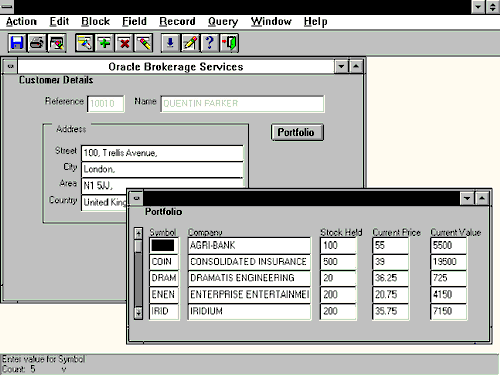
Integrating Databases and the Web
Designer/2000 exploits the sophistication of the Web as a business systems platform. It elevates the Web from a simple, static information publishing mechanism to an environment capable of supporting complex applications. Designer/2000 removes the need for mass software distribution whenever the application changes, effectively solving one of the major problems faced by companies in the move to client/server applications.
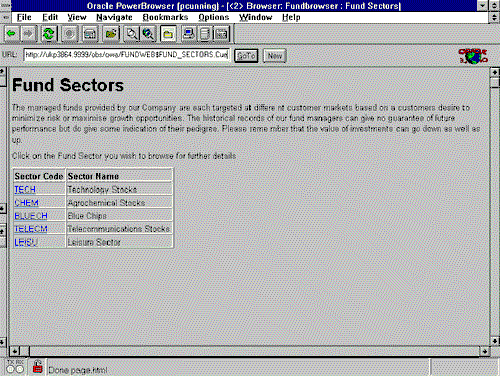
Use Oracle WebServer(tm) and Designer/2000 to provide the needed integration between Web application development tools and database servers. Extend the modeling and team-working benefits of Designer/2000 to deploying database applications on the Web using the Designer/2000 WebServer Generator. The same modeling techniques and repository-based definitions used for client/server applications, are leverated by Designer/2000 to generate and deploy Web applications.
Open Server Generation
Designer/2000 completes the delivery of enterprise applications and warehouse solutions with the creation of server-side components for a wide range of databases. Create models of snapshots, role-based security, server-side application logic in triggers, stored procedures and functions, and data storage parameters for Oracle servers. Develop distributed implementation models through the partitioning of application components at specific servers and nodes. Reverse engineer production server definitions to give developers and administrators access to sophisticated diagramming tools for management and maintenance of distributed servers.
In addition to Oracle server definitions, Designer/2000 enables forward and reverse engineering of TABLES, VIEWS, CONSTRAINTS, INDEXES, and DOMAINS for Personal Oracle Lite, Rdb, SQL Server, DB/2 and ODBC compliant databases. Use Designer/2000 to rapidly convert distributed systems design into working databases, as well as to effectively manage existing servers.
C++ Object Layer Generation
Improve the cost-effectiveness of server-oriented programming with the Designer/2000 C++ Object Layer Generator. Developer concerns about the scalability, interoperability and reliability of object databases, are overcome using the C++ Object Layer Generator. It makes Oracle7, which has no such limitations, a viable store for developers by building classes to access the target server. The Designer/2000 C++ Object Layer Generator is useful to any C++ programming project that needs a persistent store for objects. Using the Oracle7 database to provide this store, gives C++ programmers access to the industry's leading database, and the scalability, security, and data-sharing with all other applications implemented on any connected database.
MS-Help Generation
Create Microsoft Windows Help directly from module definition information recorded in the repository during the analysis and design process. Deliver practical and consistent online assistance for Windows-based applications designed and developed using the Designer/2000 Generators. Define user Help text against program modules and their table and column usages using Designer/2000 and simply generate it to build fully linked and compilable MS-Help subsystems. In this way, comprehensive and consistent user help facilities can be generated for all application types for a small incremental investment in design documentation.
Repository Administration
Employ comprehensive facilities to manage the contents of and access to the Designer/2000 repository. Divide and sub-divide definitions across multiple projects and grant users privileges that profile exactly their access needs. Promote object reuse across the development environment by providing shared definitions across multiple projects. Track and manage multiple production and development systems through powerful version control facilities. In environments calling for multiple Designer/2000 repository implementations, developers easily exploit the extract, load, and merge features to manage distributed developments.
Sophisticated, yet easy-to-use repository management facilities ensure high-value, low-cost usage of your integrated repository environment.
MANAGING THE COMPLEXITY OF
CLIENT/SERVER DESIGN
Rapid advances in technology, dynamic changes in the marketplace, and stringent, yet changing, user needs demand advanced innovation in systems development frameworks. With accurate modelling of business and systems opportunities, the refinement of these models into flexible designs, and the power of model-driven generation, Designer/2000 meets and exceeds these demands for the rapid creation of scalable systems. As your portfolio of Designer/2000-based applications grows, the value of reusable objects in your shared repository will add to the success of your systems development and maintenance efforts.
Designer/2000 delivers on the promise of model-driven development.
Oracle Corporation is the world's largest supplier of software for information management, and the world's second-largest software company. With annual revenues of more than $3.5 billion, the company offers its database, tools, and application products, along with related consulting, education, and support services, in more than 90 countries around the world.
Oracle and CASE Exchange are registered trademarks, and Enabling the Information Age, End User Layer, Oracle7, Oracle7 Server, Discoverer/2000, Designer/2000, Developer/2000, Oracle WebServer, Oracle Forms Generator, and PL/SQL are trademarks of Oracle Corporation.
All other company and product names mentioned are used for identification purposes only, and may be trademarks of their respective owners.
Copyright (c) 1996, Oracle Corporation
All Rights Reserved
Printed in the U.S.A.
0000.0696.?K
Part#: 00000